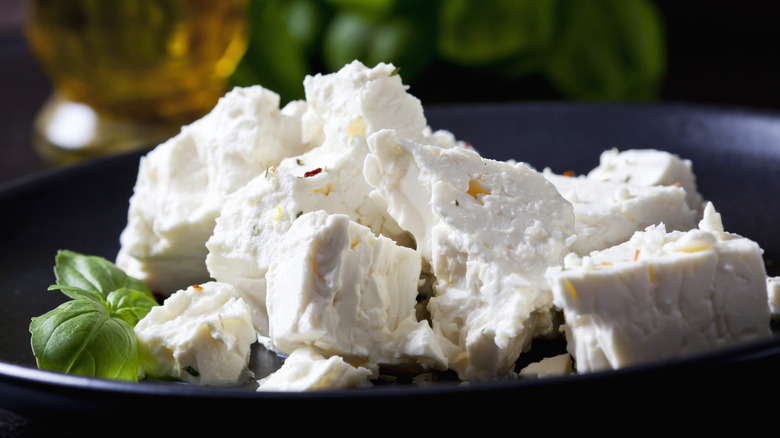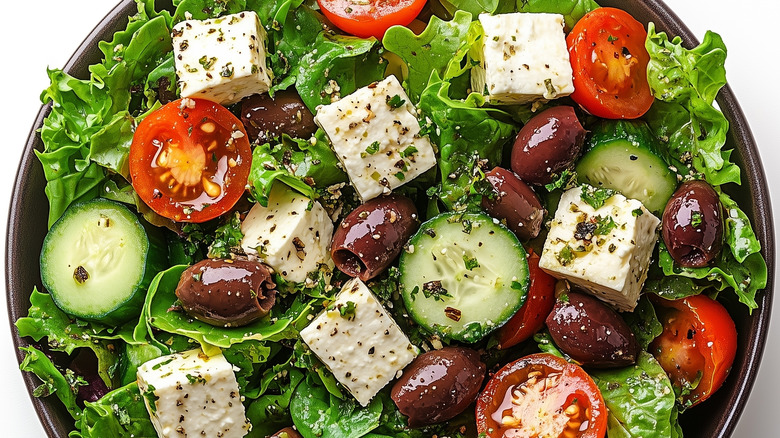The Healthy Greek Cheese That Has More Calcium Than Cottage Cheese (And Fewer Calories)
Ask any nutritionist (or cheese enthusiast), and they can easily come up with a list of reasons why eating cottage cheese is good for you, especially when compared to other cheeses. It all comes down to the cheese's nutritional value: a 100-gram serving of full-fat cottage cheese contains 11.6 grams of protein, 154 milligrams of phosphorus, 9.2 milligrams of magnesium, and 88 milligrams of calcium. It's also relatively low in fat (4.22 milligrams) and sodium (350 milligrams), and clocks in at just a little over 100 calories.
However, there's a slightly less popular (though no less tasty) Greek cheese that beats cottage cheese, gram for gram, in terms of essential nutrient content: feta cheese. A soft, white cheese made from the milk of sheep or goats, feta cheese has 14.2 grams of protein, 337 milligrams of phosphorus, 19 milligrams of magnesium, and a whopping 493 milligrams of calcium (yep, more than five times the amount found in cottage cheese) in every 100-gram serving.
The health benefits of consuming feta cheese
Given its nutritional composition, it's no surprise that feta is one of the healthiest kinds of cheese you can eat. Every health buff knows that protein is crucial for numerous bodily functions, perhaps most notably muscle development and recovery. But working in unison with calcium and phosphorus, protein also ensures strong bone development, with the latter two nutrients critical for bone density and composition, as well as osteoporosis prevention.
Aside from that, incorporating feta cheese into your diet may lead to a happy gut as well. According to a 2006 study in the International Dairy Journal, Lactobacillus plantarum, a probiotic found in feta cheese, has been observed to enhance the body's immune response against particularly dangerous pathogens like Salmonella and E. coli, on top of improving overall gut health.
Another component of feta cheese with disease-preventing potential is a fatty acid called conjugated linoleic acid (CLA). Not only has this been reported to play a role in fighting cancer, diabetes, and atherosclerosis (plaque buildup in the arteries), but it may also help with reducing body fat while increasing lean body mass (via a 2004 article in the Journal of the American Dietetic Association).
The best ways to enjoy feta cheese
With all that said, too much of a good thing isn't good — and if you're not careful about how much feta cheese you consume, you may very well put your health at risk.
Feta cheese has nearly triple the amount of sodium that cottage cheese has, topping out at a staggering 1,140 milligrams per 100-gram serving. (It also has more than five times the fat content, at 21.5 grams.) The high sodium content in feta cheese is a result of the brining process through which it is made. Fortunately, you can remedy this by rinsing the feta before consumption. Also, lactose-intolerant folks may want to steer clear of feta, as well as other unripened cheeses, which tend to be abundant in lactose. Lastly, with 265 calories per 100-gram serving, feta has more than double the calories of cottage cheese.
The key is to consume feta cheese in moderation. Finding creative ways to add feta cheese to your diet can help; fortunately, it is as versatile as it is nutritious. You can spread it on bread, add some cubes to your salad, serve it alongside fruits on a charcuterie board, use it as a topping for pizza, tacos, or pasta, and even try creative recipes such as tofu feta or spinach and feta omelette.


